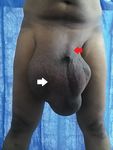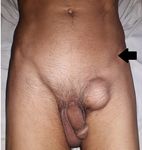A Guide for Identification of Different Types of Hernias
←
→
Page content transcription
If your browser does not render page correctly, please read the page content below
ISSN: 2474-3682
Mulkalwar et al. Clin Med Img Lib 2021, 7:185
DOI: 10.23937/2474-3682/1510185
Volume 7 | Issue 3
Clinical Medical Image Library
Open Access
Image Article
A Guide for Identification of Different Types of Hernias
Alhad Mulkalwar*, Apoorva Doshi, Tanmay Jadhav and Samir Deolekar
Department of General Surgery, Seth Gordhandas Sunderdas Medical College and King Edward Memorial Check for
Hospital, Mumbai, India updates
*Corresponding author: Alhad Mulkalwar, Intern (M.B.B.S), Seth Gordhandas Sunderdas Medical College and King
Edward Memorial Hospital, Acharya Donde Marg, Parel, Mumbai 400012, India
Introduction groin (Figure 2). It is a case of left sided femoral hernia.
In order to differentiate it from other types of swellings,
A hernia is defined as an abnormal protrusion of a
one has to look for certain features. For instance, it
viscus or part of a viscus through a normal or abnormal
classically presents as a globular rounded swelling
opening in the cavity in which it is contained. It is an area
on inspection. Another important feature of hernial
of weakness or disruption of the fibromuscular tissues
swellings is increase in size with physical activity like
of the body wall. Inguinal hernia is the most common
walking or straining and relative reduction in size
type of hernia (73%), followed by incisional (15%) and
when lying down. Clinically, it can be elicited by
then femoral hernia (7%). This article describes these
asking the patient to cough. An increase in size
common types of hernias with an example of each,
following coughing (known as a positive cough impulse)
along with their major characteristics and identification
would confirm it as a hernia. Absence of change is size
features.
of swelling while walking or straining or a negative cough
Inguinal Hernia impulse does not rule out hernia but their presence
is a very specific sign of hernia. It is also important to
Figure 1 depicts a case of bilateral inguinal hernia
differentiate it from the more common inguinal hernia.
with the scrotal swelling on the right side being
For this, one needs to look at the boundaries of this
larger than that on the left. Typical presentations
swelling. It can be appreciated that the medial most
include swelling in the inguino-scrotal region. The
borders are just lateral to the path of inguinal canal. This
usual features of identification for hernia apply here as
is a very useful visual distinguishing feature for femoral
well but this patient has a severely enlarged globular
hernias as inguinal hernias present initially along the
swelling that has made even the identification of penile
path of inguinal canal and later in the scrotal region
shaft difficult. This is not usually seen in other causes of
whereas femoral hernias present along the path of the
scrotal swelling such as testicular cancer or hydrocoele
femoral canal. Another way to distinguish it involves
and it indicates that the contents of the swelling have
palpation of swelling- neck of femoral hernia lies below
come from outside the scrotal sac. This is a very useful
and lateral to the pubic tubercle while that of inguinal
visual identification feature. Hernias of this size tend
hernia lies above and medial to the pubic tubercle.
to be irreducible. Another important visual finding in
this case is the appearance of redness of the scrotal Incisional Hernia (Reducible)
swelling. It is a sign of strangulation of hernia and
An incisional hernia is a protrusion of tissue that
warrants further physical examination to confirm the
forms at the site of a healing surgical scar. While a
same.
distinct scar of a prior surgery is visible in Figure 3,
Femoral Hernia the same cannot be clearly appreciated in Figure 4.
Hence, it becomes important to take a detailed history
The patient presented with a globular swelling in the
of any past surgery to differentiate incisional hernias
Citation: Mulkalwar A, Doshi A, Jadhav T, Deolekar S (2021) A Guide for Identification of Different
Types of Hernias. Clin Med Img Lib 7:185. doi.org/10.23937/2474-3682/1510185
Accepted: September 27, 2021; Published: September 29, 2021
Copyright: © 2021 Mulkalwar A, et al. This is an open-access content distributed under the terms of the
Creative Commons Attribution License, which permits unrestricted use, distribution, and reproduction
in any medium, provided the original author and source are credited.
Mulkalwar et al. Clin Med Img Lib 2021, 7:185 • Page 1 of 4 •DOI: 10.23937/2474-3682/1510185 ISSN: 2474-3682
Figure 1: Large scrotal swelling with redness (white arrow). The red arrow points towards the penile shaft.
Figure 2: Swelling in the upper and medial region of the left thigh, immediately lateral to groin. The arrow points towards the
position of the left inguinal ligament overlying the inguinal canal.
from other types of hernias. These hernias are reducible examination. The expansile impulse over the swelling
which means that the contents of the swelling can be when the patient coughs implies a positive cough
reduced into the abdominal cavity at rest, when the impulse. Movement or increase in tension of a swelling
intra-abdominal pressure is not high. In both these cases, without expansion is not considered as a positive cough
a positive cough impulse can be elicited. Cough impulse is impulse.
the most specific sign for diagnosis of a hernia on clinical
Mulkalwar et al. Clin Med Img Lib 2021, 7:185 • Page 2 of 4 •DOI: 10.23937/2474-3682/1510185 ISSN: 2474-3682
Figure 3: Front (A) and side (B) view of a patient with an anterior abdominal swelling at rest. A midline surgical scar can be
clearly appreciated (A). Increase in size of swelling on coughing - positive cough impulse (C).
Figure 4: Front (A) and side (B) view of a patient with an anterior abdominal swelling at rest. Increase in size of swelling on
coughing - positive cough impulse (C).
Incisional Hernia (Irreducible) past surgery. Irreducible hernias cannot be pushed back
manually through the opening in the abdomen because
Figure 5 and Figure 6 depict two cases of irreducible
they are trapped outside the abdominal muscle wall.
incisional hernia. The easiest identifying feature of
Hence, cough impulse may not be always elicited . Unlike
incisional hernia is the presence of the scar over central
reducible incisional hernia, where the gap in the anterior
point of the swelling (Figure 5), although it may not
abdominal wall can be distinctly appreciated with the
always be clearly appreciable (Figure 6). Hence, it
fingers on contracting the abdominal wall muscles, it
becomes important to take a detailed history of any
may not be felt properly in cases of irreducible hernia
Mulkalwar et al. Clin Med Img Lib 2021, 7:185 • Page 3 of 4 •DOI: 10.23937/2474-3682/1510185 ISSN: 2474-3682
Figure 5: Large abdominal swelling with midline scar front (A) and side (B) view. A midline surgical scar can be clearly
appreciated.
Figure 6: Large, protroding anterior abdominal swelling at rest.
Mulkalwar et al. Clin Med Img Lib 2021, 7:185 • Page 4 of 4 •You can also read
























































